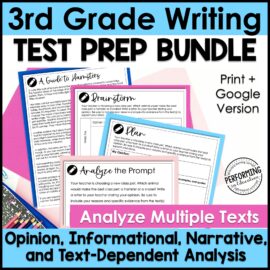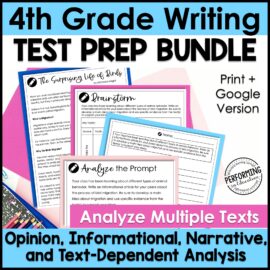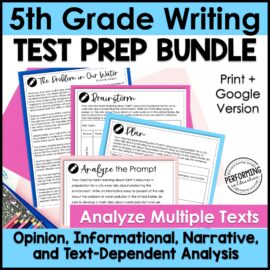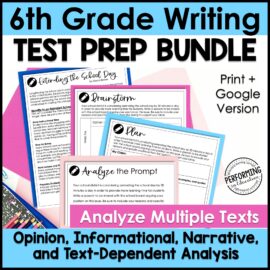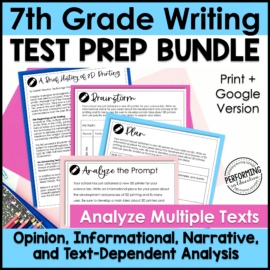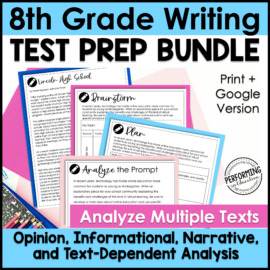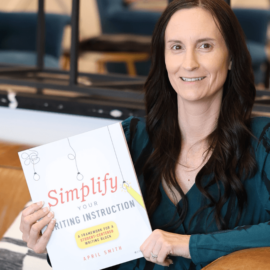When spring rolls around, I know it’s time to break out the writing prompts and start TEST PREP. As teachers we often feel as much anxiety about testing as our students, but I’m here to tell you it doesn’t have to be that way!
There’s a lot about testing that’s out of our control, so it’s best to focus on what we can control: giving our students the strategies they need to feel confident and equipped.
I’m going to walk you through how I prepare my students for the state writing test, and share some FREE writing prompts you can use to practice. These prompts cover a variety of writing types: personal narrative, explanatory, opinion, and creative narrative, so you’ll have exactly what you need to practice each kind of writing.
Break Down the Writing Prompts
I begin by displaying the writing prompts for the class and give students their own copy to write on. First, we read the prompt aloud (and slowly!) at least 2 times. Next, we critically break down the prompt. I love using the R.A.F.T.S. acronym to help students remember each part:

- Role: Who is doing the writing? Some writing prompts ask students to imagine they are a reporter, a historian, or a famous person. (But often, the “role” is just the student himself.)
- Audience: Who are you writing to? A prompt might ask students to write a letter to the editor (audience=local community) or a report for their class (audience=peers). If no audience is stated in the prompt, students can choose their own appropriate audience.
- Format: What type of writing is it? Some possibilities include: fictional story, opinion piece, newspaper article, explanatory piece, letter, diary entry, etc.
- Topic: What should the writing be about? This is the main content of the writing; in the prompt pictured above, the topic is “the crazy events that happen that make you late to the event”.
- Strong Verb: What is the purpose or reason for writing? Writing prompts often include a powerful verb such as “persuade”, “inform”, or “explain”.
After I’ve introduced the R.A.F.T.S. strategy, my students learn to quickly jot down each letter along the edge of their paper and fill in each part with information from the prompt. We highlight, circle or underline words in the prompt too. This helps them really understand what the prompt is asking them to do, and ensures they are on the right track before they even begin writing!
This really helped with preparing my kids for the state test! They had to “figure out” what kind of writing genre they needed to write. Thank you!
-Jane, 4th grade teacher
Model the Brainstorming and Planning Process
Left alone, most students will read a writing prompt and immediately jump into their rough draft. But we know how essential it is for students to spend a little time brainstorming and planning! I like to model the importance of this step in a silly way, thinking aloud and over-exaggerating:
“I’ve just read the writing prompt for this test. Now I’m totally ready to write my final draft! ‘Once upon a time…'” I pretend to write until my students shout, “Wait! You forgot to brainstorm!” It works every time!
I always encourage my students to spend AT LEAST 5-10 minutes planning before they begin to write. I model this by teaching my students to use some basic graphic organizers. (These are included in the free resource above!) At the beginning, I provide the organizers to go with the writing prompts, but I also make sure to teach them how to draw out their own versions so they can use this strategy during the state writing test.

Emphasize Revision
If your state uses a computer-based writing test, this step is especially crucial! Most students are used to writing out a separate rough draft, revising/editing it, and then copying a neat version for the final copy. But on the computer, the rough draft “looks” complete when students finishing typing the last word! We must teach our students to spend time proofreading.

We use writing checklists all year long, so when we get to the revision stage during test practice, I have my students imagine the checklist in their head: how many items can they remember? I urge them to jot these down so they can remember what to check for in their writing.
In general, I want my students to first check to make sure their writing aligns with the prompt. Next, they reread their draft, focusing on these categories:
- Organization: Are related ideas grouped together?
- Elaboration: Is there any place that needs more details or examples?
- Word Choice: Is the vocabulary precise and complex?
I encourage my students to find at least 3 places where they can enhance their writing before moving on to check the conventions (capitalization, spelling, punctuation, and grammar).
Use Multiple Writing Prompts
Finally, give lots of opportunities for practice! I use several writing prompts for test prep: we start by doing a few whole-class practice sessions (limiting the work time to one class period), working together to analyze the prompt and brainstorm.Later, I allow the students more independent practice, going from start to finish completely on their own.
If at all possible, try to do at least some of your writing test prep in the same format as the real test. So if your students will be using a computer, let them practice on the computer too! The free prompts I’ve provided can easily be used on individual devices: just copy the half-page prompts and assign to students on Google.
My state offers sample tests of the writing test online. These are helpful because students can see the exact website that will be used, and can practice writing without the aid of spellcheck. I highly recommend checking to see if your state provides sample tests!

Keeping a positive mindset about testing is key! When you feel confident, your students will too. If you’re looking for more comprehensive test prep, you can sign up below for my FREE writing test prep unit, which includes:
- Teacher guide
- RAFT response acronym
- Sentence starters scaffold
- Text annotation bookmark
- Text-dependent writing checklist
- Prompt analysis checklist
- Engaging texts
- Note-taking graphic organizer
- Rubric
- Exemplars
- Publishing pages

